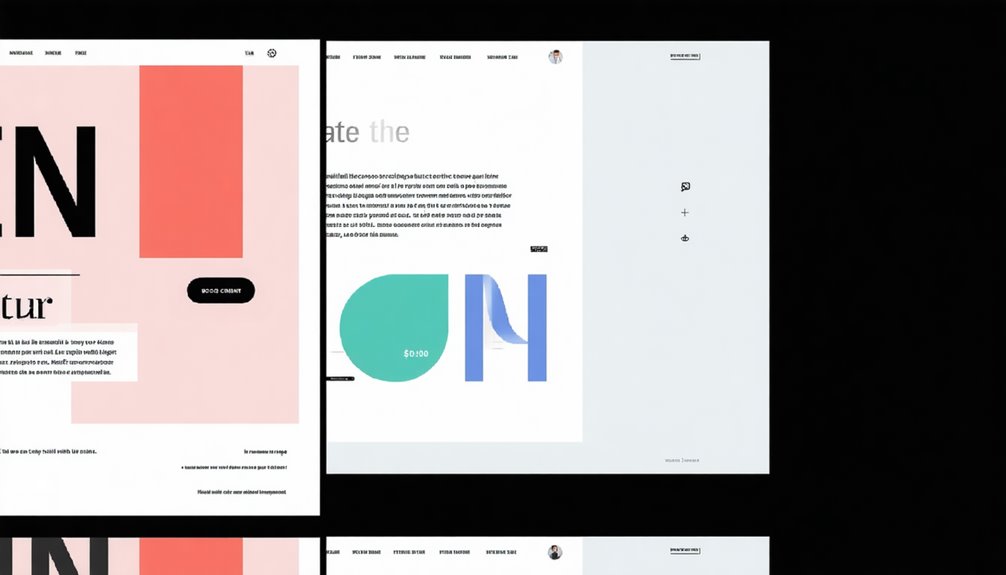Innovative web design trends focus on engaging user interaction through scrolling and parallax effects, gamification features, and interactive video elements. Visual appeal is heightened by negative space utilization, custom illustrations, and bold typography, emphasizing brand identity and clear communication. Integration of 3D models and VR elements is enhancing user experiences, particularly in industries like real estate and retail. Prioritizing user experience (UX) through intuitive navigation and mobile-first design strategies guarantees higher customer satisfaction and conversion rates. The incorporation of these elements represents the cutting-edge trends in web design, reflecting a broader shift towards dynamic and immersive online environments.
Scrolling and Parallax Effects

Scrolling and parallax effects have become integral components of modern web design, revolutionizing the way users interact with websites. Scrolling animations are designed to enhance user engagement by triggering visual effects based on their scroll actions. These animations create a dynamic browsing experience, encouraging users to explore further.
On the other hand, parallax scrolling involves multiple layers of content moving at different speeds, providing a sense of depth and enriching storytelling through layered presentations. Websites often utilize full-width images and multimedia in parallax scrolling to captivate users and maintain their interest as they navigate through the site.
The Cookery School, for example, effectively implements scrolling animations to enhance visual appeal and encourage content exploration. Parallax effects can markedly improve user retention and interaction time by creating visually engaging narratives that entice users to scroll further, making the browsing experience more immersive and interactive.
Micro-Interactions and Micro-Animations
The integration of micro-interactions and micro-animations represents a significant advancement in contemporary web design, offering subtle yet impactful feedback mechanisms for users.
Micro-interactions, such as changing link colors on hover, play an essential role in enhancing engagement and interaction visibility on websites. These small, subtle animations guide users through actions and responses, contributing to a more dynamic user experience.
As for micro-animations, slightly more extended than micro-interactions, they can introduce a playful element to user interfaces, especially in e-commerce settings where they showcase product movements and enhance visual storytelling.
Effective deployment of micro-interactions and micro-animations can greatly enhance user retention and satisfaction by creating an intuitive and enjoyable interface.
Research suggests that users are more inclined to engage with websites that incorporate thoughtful animations as they draw attention, clarify actions, and provide a delightful user experience.
As these trends continue to gain traction, web designers are expected to leverage micro-interactions and micro-animations more prominently to improve conversion rates and overall user experience.
Visual Design and Aesthetics

Embracing contemporary web design principles, the integration of negative space, custom illustrations, frosted glass effects, bold typography, and vibrant gradients has greatly reshaped the visual landscape of websites.
Negative space, strategically incorporated, enhances readability and user experience by providing visual breathing room for key elements.
Custom illustrations, preferred for their ability to convey brand identity and evoke emotions, are replacing generic stock images.
Frosted glass effects add a touch of modernity, improving text legibility and adding depth to website designs.
Bold typography, with oversized and unique fonts, serves as a powerful design element, making a strong visual impact and bolstering brand recognition.
Gradients, evolving from subtle overlays to vibrant features, bring depth and dynamism to web aesthetics.
These trends reflect a shift towards cleaner, more engaging designs that prioritize clarity, creativity, and user experience.
Customization and Unique Visuals
Moving forward from the domain of visual design and aesthetics, the sphere of web design is undergoing a significant shift towards customization and unique visuals.
Custom illustrations are taking precedence over stock images in website design, enhancing brand identity and storytelling. By blending photos with graphical elements, designers create engaging visual combinations that foster creativity and reinforce brand identity.
Bespoke graphics are increasingly utilized to reflect individual brand personality, with reports indicating that custom illustrations help differentiate work from competitors. Additionally, the trend towards personalized visuals is driven by the desire for deeper engagement, as customized content has been shown to increase conversion rates by up to 20% in custom ecommerce website development.
Furthermore, the use of organic shapes and fluid design elements is gaining prominence, moving away from rigid geometric patterns towards softer, more inviting user experiences that mimic natural forms.
As web design continues to evolve, the emphasis on customization and unique visuals is becoming essential for creating impactful online experiences.
3D and VR Elements

A surge in demand for immersive online experiences has propelled the integration of interactive 3D models and Virtual Reality (VR) elements into contemporary web design practices. Websites are now incorporating these cutting-edge technologies to enhance user engagement, particularly in web branding and online shopping experiences.
The use of interactive 3D models allows customers to interact with products in a more realistic way, fostering confidence and increasing conversion rates. Additionally, VR elements are being leveraged to create immersive experiences like virtual tours and product visualizations, benefiting industries such as real estate and retail.
The trend towards incorporating these 3D and VR elements is expected to grow considerably as brands seek to differentiate themselves in competitive markets by offering unique and engaging user interactions. Research indicates that integrating VR features can lead to higher user engagement rates, ultimately boosting visitor retention and conversion rates.
This shift towards more immersive web design reflects a broader trend in creating interactive online environments that cater to the evolving preferences of digital consumers.
Design Styles and Trends
The evolution of web design trends extends beyond immersive technologies like 3D and VR elements to encompass a diverse range of design styles and aesthetics that shape the digital landscape.
Web designers and developers are constantly exploring new avenues to enhance website design, incorporating various trends to captivate users and deliver engaging online experiences.
One prominent design style making waves in the industry is Material Design, developed by Google, which utilizes bold colors and shadows to create depth in user interfaces.
Art Deco Revival, with its blend of geometric shapes and ornate details, offers a visually striking approach to website design.
Maximalism, embracing vibrant colors and bold visuals, appeals to younger audiences, while the Y2K Aesthetic merges retro elements with contemporary styles to cater to digitally fluent users.
Additionally, the rising popularity of Dark Mode designs, reducing eye strain and enhancing readability, indicates a shift towards user-focused experiences in web design.
As these trends continue to evolve, web designers and developers play a vital role in shaping the aesthetic of modern websites.
Gamification and Engagement

Harnessing the power of interactive elements and game-like mechanics, gamification in web design has emerged as a strategic approach to boost user engagement and drive interaction on digital platforms.
By incorporating elements such as points, badges, and leaderboards, websites can enhance user experiences and encourage active participation. Interactive challenges and quizzes within gamified designs have shown to increase user retention by up to 30%, indicating a significant impact on user behavior.
Brands implementing gamification strategies have reported a 50% rise in user engagement, showcasing the effectiveness of playful interactions in capturing user attention.
Gamification also allows for the integration of personalized rewards and incentives, which not only motivate users but also create a deeper emotional connection to the brand.
E-commerce sites leveraging gamified features, like reward systems for repeat purchases, have witnessed conversion rates spike by up to 20%. This highlights the economic advantages of incorporating gamification into web and ecommerce website design near me.
Video and Content Integration
Integrated video content has become a cornerstone of contemporary web design, playing a pivotal role in elevating user engagement and fostering credibility through purposeful visual storytelling.
Smart video integration has evolved into an essential tool for website designers and developers, going beyond simple embedding techniques to drive conversions effectively. Engaging video backgrounds are on the rise, creating dynamic and immersive experiences that captivate users and enhance storytelling.
Research underscores the significance of video on websites, showing an increase in user retention by up to 80% when video content is featured. Brands are leveraging video to convey information efficiently, with studies indicating that viewers retain 95% of a message when presented in video format.
The incorporation of interactive video elements is a growing trend, providing users with personalized experiences that boost engagement and conversion rates. Web developers near me are increasingly focusing on optimizing video and content integration to create impactful and memorable online experiences for users.
Frequently Asked Questions
What Is the New Trend in Web Design?
The new trend in web design revolves around embracing hyperreality, interactive whimsy, digital sustainability, Y2K aesthetics, and personalized experiences. These elements converge to create visually engaging websites that prioritize user engagement, environmental consciousness, and tailored content delivery.
What Is the Future of Web Design in 2024?
In 2024, the future of web design will emphasize sustainability, personalization, immersive multimedia experiences, dark mode designs, and bold typography. These trends aim to enhance user engagement, reduce environmental impact, and create enchanting, user-centric digital experiences.
Which Design Is Trending Now?
Hyperreality, interactive whimsy, Y2K aesthetic, maximalism, and sustainable practices are currently trending in design. These concepts blend digital experiences, incorporate playful elements, evoke nostalgia with modern twists, use bold visuals, and focus on eco-friendly solutions, respectively, to engage audiences effectively.
What Will the Next Big Design Trend Be?
The next significant design trend is likely to focus on enhanced user engagement through interactive whimsy, blending playful elements like animated logos and 3D objects. This trend aims to counter digital fatigue and create immersive digital experiences for users.
Conclusion
To sum up, the latest trends in web design include scrolling and parallax effects, micro-interactions and micro-animations, visual design and aesthetics, customization and unique visuals, 3D and VR elements, design styles and trends, gamification and engagement, as well as video and content integration. These trends are shaping the way websites are designed and interacted with, enhancing user experience and engagement on digital platforms. Web designers should continue to stay updated on these trends to create visually appealing and engaging websites.




0 Comments